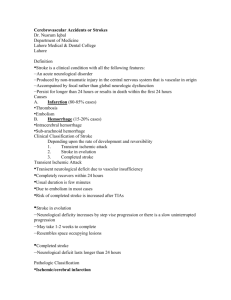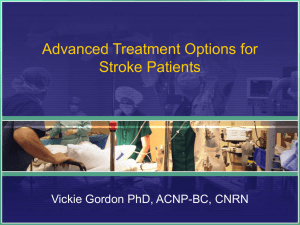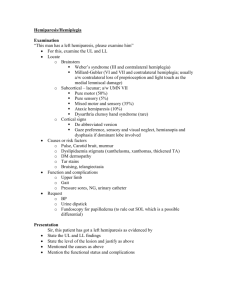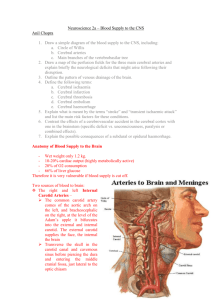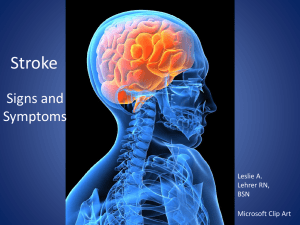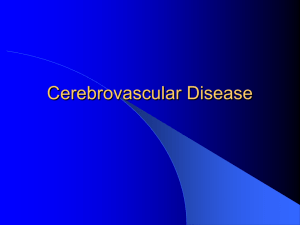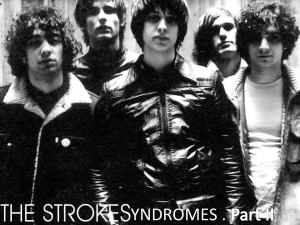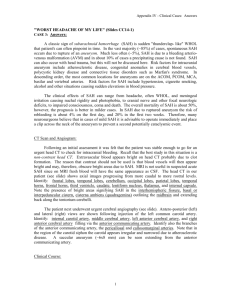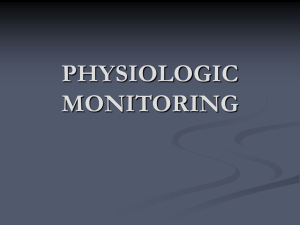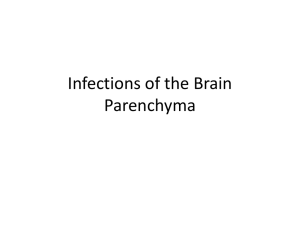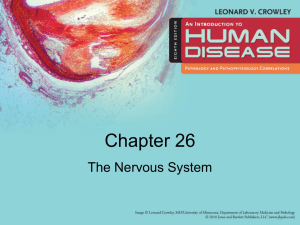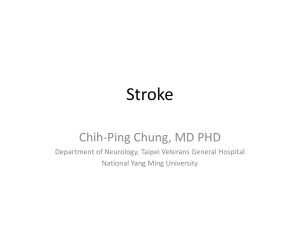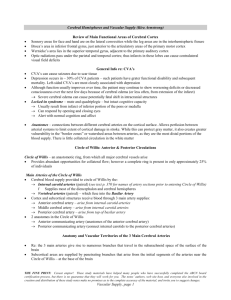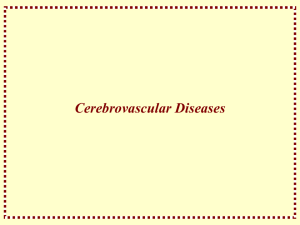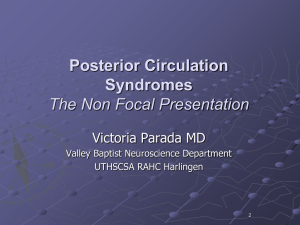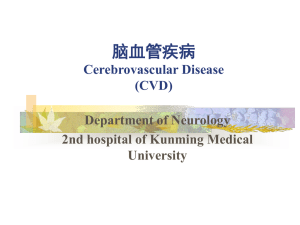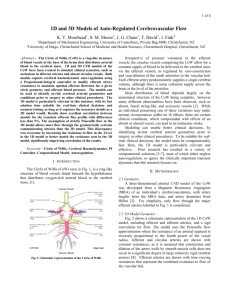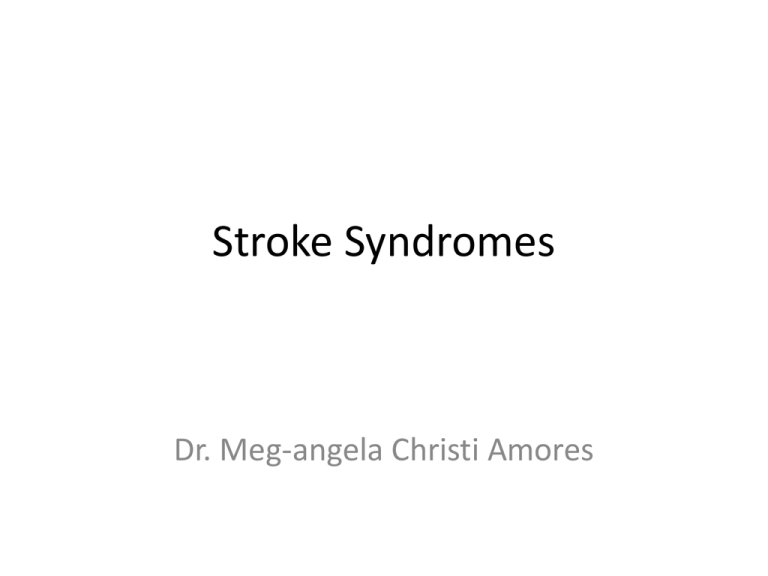
Stroke Syndromes
Dr. Meg-angela Christi Amores
Stroke
• Cerebrovascular disease
• ischemic stroke, hemorrhagic stroke, and
cerebrovascular anomalies such as intracranial
aneurysms and arteriovenous malformations (AVMs)
• Stroke
• abrupt onset of a neurologic deficit that is attributable
to a focal vascular cause
• Ischemic or hemorrhagic
Stroke
• Ischemic Stroke
• Acute occlusion of an intracranial vessel causes
reduction in blood flow to the brain region it supplies
• A fall in cerebral blood flow to zero causes death of
brain tissue within 4–10 min
• values <16–18 mL/100 g tissue per min cause infarction
within an hour
• values <20 mL/100 g tissue per min cause ischemia
without infarction unless prolonged for several hours or
days
Ischemic stroke
• Ischemic penumbra
• Tissue surrounding the core region of infarction that is
ischemic but reversibly dysfunctional
• will eventually infarct if no change in flow occurs
• Fever dramatically worsens ischemia, as does
hyperglycemia[glucose > 11.1 mmol/L (200
mg/dL)], so it is reasonable to suppress fever
and prevent hyperglycemia as much as
possible
Ischemic Stroke
• Pathophysiology
• 1) occlusion of an intracranial
vessel by an embolus that
arises at a distant site
• (2) in situ thrombosis of an
intracranial vessel, typically
affecting the small
penetrating arteries that arise
from the major intracranial
arteries
• (3) hypoperfusion caused by
flow-limiting stenosis of a
major extracranial
Stroke Syndromes
• Patient presentation can localized area of the
brain affected/ blood vessel occluded
• Divided into:
– (1) large-vessel stroke within the anterior
circulation
– (2) large-vessel stroke within the posterior
circulation
– (3) small-vessel disease of either vascular bed
Stroke within the Anterior Circulation
Middle Cerebral Artery
Middle Cerebral Artery
• If occluded at its origin:
– contralateral hemiplegia
– Hemianesthesia
– homonymous hemianopia
– gaze preference to the ipsilateral side
– If dominant hemisphere: global aphasia
– If non-dominant hemisphere: anosognosia,
constructional apraxia, and neglect
Middle Cerebral Artery
• Somatic motor area for face and arm and the
fibers descending from the leg area to enter
the corona radiata and corresponding somatic
sensory system
• Paralysis of the contralateral face, arm, and leg;
• sensory impairment over the same area (pinprick,
cotton touch, vibration, position, two-point
discrimination, stereognosis, tactile localization,
barognosis, cutaneographia)
Middle Cerebral Artery
Middle Cerebral Artery
• Motor aphasia: Motor speech area of the
dominant hemisphere
• Central aphasia, word deafness, anomia, jargon
speech, sensory agraphia, acalculia, alexia, finger
agnosia, right-left confusion (the last four
comprise the Gerstmann syndrome): Central,
suprasylvian speech area and parietooccipital
cortex of the dominant hemisphere
• Conduction aphasia: Central speech area (parietal
operculum)
Middle Cerebral Artery
• Homonymous hemianopia (often
homonymous inferior quadrantanopia): Optic
radiation deep to second temporal convolution
• Paralysis of conjugate gaze to the opposite
side: Frontal contraversive eye field or
projecting fibers
Anterior Cerebral Artery
Anterior Cerebral Artery
Anterior Cerebral Artery
• anterior limb of the internal capsule, the
anterior perforate substance, amygdala,
anterior hypothalamus, and the inferior part
of the head of the caudate nucleus
• Occlusion of the proximal ACA is usually well
tolerated because of collateral flow through
the anterior communicating artery and
collaterals through the MCA and PCA
Anterior Cerebral Artery
• Paralysis of opposite foot and leg: Motor leg
area
• A lesser degree of paresis of opposite arm:
Arm area of cortex or fibers descending to
corona radiata
• Cortical sensory loss over toes, foot, and leg:
Sensory area for foot and leg
• Urinary incontinence: Sensorimotor area in
paracentral lobule
Anterior Cerebral Artery
Anterior Cerebral Artery
• Abulia (akinetic mutism), slowness, delay,
intermittent interruption, lack of spontaneity,
whispering, reflex distraction to sights and
sounds: Uncertain localization—probably
cingulate gyrus and medial inferior portion of
frontal, parietal, and temporal lobes
• Impairment of gait and stance (gait apraxia):
Frontal cortex near leg motor area
• Dyspraxia of left limbs, tactile aphasia in left
limbs: Corpus callosum
Stroke within the Posterior Circulation
• Posterior Cerebral Artery
– result from atheroma formation or emboli that
lodge at the top of the basilar artery
Posterior Cerebral Artery
• P1 Syndromes
• third nerve palsy with contralateral ataxia (Claude's
syndrome) or with contralateral hemiplegia (Weber's
syndrome)
• contralateral hemiballismus (if subthalamic n)
• thalamic Déjerine-Roussy syndrome - contralateral
hemisensory loss followed later by an agonizing,
searing or burning pain in the affected areas
Posterior Cerebral Artery
• P2 Syndromes
• infarction of the medial temporal and occipital lobes
• Contralateral homonymous hemianopia with macula
sparing
• acute disturbance in memory (hippocampus)
• peduncular hallucinosis - visual hallucinations of
brightly colored scenes and objects
• infarction in the distal PCAs produces cortical blindness
• Anton's syndrome – unaware of blindness and in denial
Basilar Artery
• Complete basilar occlusion :
• a constellation of bilateral long tract signs (sensory and
motor) with signs of cranial nerve and cerebellar
dysfunction
• “locked-in" state of preserved consciousness
with quadriplegia and cranial nerve signs
suggests complete pontine and lower
midbrain infarction
Imaging
• CT Scan
• identify or exclude hemorrhage as the cause of stroke
• the infarct may not be seen reliably for 24–48 h
• may fail to show small ischemic strokes in the posterior
fossa
• MRI
• reliably documents the extent and location of infarction
in all areas of the brain
• less sensitive than CT for detecting acute blood
Imaging
• Cerebral Angiography
• "gold standard" for identifying and quantifying
atherosclerotic stenoses of the cerebral arteries
• used to deploy stents within delicate intracranial
vessels
• intraarterial delivery of thrombolytic agents
Primary and Secondary Prevention
• General Principles
• medical and surgical interventions
• lifestyle modifications
• Evaluation of a patient's clinical risk profile
• Atherosclerosis risk factors
• Older age, family history of thrombotic stroke, diabetes
mellitus, hypertension, tobacco smoking, abnormal
blood cholesterol [particularly, low high-density
lipoprotein (HDL) and/or high low-density lipoprotein
(LDL)
Primary and Secondary Prevention
• Antiplatelet Agents
• inhibiting the formation of intraarterial platelet
aggregates
• Aspirin, clopidogrel, and the combination of aspirin plus
extended-release dipyridamole
• Aspirin dose: 50–325 mg/d
• Anticoagulation
• For AF patients: Warfarin

